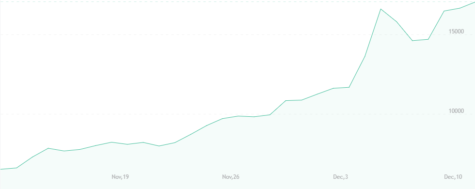Disclaimer: This article is not and does not contain investment advice. Its content should be used for informational purposes only.
By: Clayton Bonigut | Writer
December 12, 2017
In just the last few weeks, bitcoin and other major cryptocurrencies (other “coins”) have seen exponential growth in their value. Bitcoin, Litecoin and Ethereum, three of the top cryptocurrencies by market cap, all broke past their all-time highs within the last 24 hours, each up over 100% compared to the end of November. Bitcoin cleared its all-time high of $10,000 just two weeks ago, and now it’s contesting $20,000 on some exchanges. Believe it or not, this behavior is almost common for cryptocurrencies in 2017.

The insane volatility of the cryptocurrency market comes from the way that this kind of money is adopted by consumers. By understanding what cryptocurrencies are and how transactors use them, we can start to figure out why, seemingly out of nowhere, their values are beginning parabolic climbs.
Cryptocurrencies are a special type of money that make use of cryptography to verify transactions. This means that they can be decentralized; there’s no need for a central bank to control how the money is managed. In an age where fear of government control is becoming increasingly popular, this system of exchanging capital is far more appealing to many. With cryptocurrency, the money of the user is entirely in their control— they can spend it on whatever they want, whenever they want, and there are no additional fees or taxes for creating transactions. Banks don’t manage funds, so all cryptocurrency is as liquid as money can be.
Because there aren’t any central institutions to create coins in the cryptocurrency economy, there’s a system in place to create them automatically. People called “miners” run computers that verify pending transactions, and in return, they’re rewarded with the random chance of receiving units of that cryptocurrency. The rewards from mining go directly to the wallets of the miners, so they can spend them as soon as they contribute a significant amount of work to the system.
While traditional currency is most often spent on goods and services, cryptocurrencies are most often spent in exchanges to regulated currencies or other cryptocurrencies. A study taken in the summer of this year showed that less than one percent of all bitcoin transactions were made with the intention of trading goods or services. This may sound like a bad thing because consumers aren’t buying actual products, but it’s actually the most important factor of these skyrocketing markets. The currency exchanges themselves are the sole determinants of value for most coins. The risks and predictions that investors make into the platforms drive the market in an untraditional way, causing some of the quickest inclines and declines in value that any market on earth sees.
These crazy jumps in value within days and weeks are actually quite common for cryptocurrencies. There aren’t too many specific causes for this surge that are wildly different from the past. As cryptocurrencies, mainly bitcoin, become more mainstream and adopted by companies and retailers, this upward trend has a good shot at continuing its path.
For most of the students I had a chance to talk to, they’re hopeful about the future of crypto. Some are even financially invested in them already.
For example, junior Dylan Brophy runs his own ethereum mining equipment at home, because the profits he takes in easily pay off the cost of electricity in this area. He’s convinced that it will stay profitable no matter what the market does, because the laws of supply and demand will ensure that mining payouts are always relevant. “I think it’ll continue for a long time. Mining is a win-win for me right now.”
However, a few are understandably skeptical about what comes next. Senior Adeeb Tajalli is concerned that “the price can’t just go up forever,” and that “it’s not worth investing into something that’s so risky.”
Whether it will continue to go up or crash back down, the cryptocurrency markets will continue to fluctuate to a great degree. These are some of the least predictable and wildest markets of all, and you’re bound to hear about them more often as we see adoption happen over time.

Leave a Reply